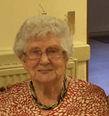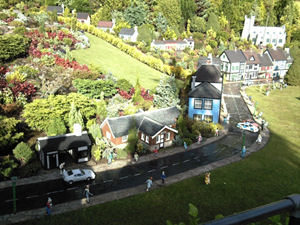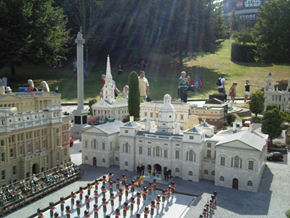Dates for your Diary
Closed until further notice.
Museum opening times
Closed until further notice.
100 Club
The last 100 club drawn was in March 2020 and since then the museum has, of course, been closed. The next draw will be in whatever month we re-open and any monies we are currently holding for members will automatically be entered into that and subsequent draws.
AGM 2020
Thank you to everyone who sent in their voting sheets and apologies we were not able to meet you in person this year. The only major change this year is that Mrs Jen Price is standing down as Treasurer though staying on as a Director and committee member. Mrs Karen Pratley has kindly agreed to step into the role of Treasurer for which we thank her. All other posts remain the same as previously though Don Bearcroft is now an ‘Honorary’ Curator in an advisory capacity only.
Condolences
 It is with deep regret that I have to report that a long-standing supporter, Mrs Vera Smith, has passed away. Vera was a personal friend; she and my mother (also deceased) were lifelong friends and to me and my sister, she will always be our ‘Aunty Ve’. Our two families were very close and we spent many a holiday together both at home and abroad. Vera was an avid reader of this newsletter and often helped out with contributions for it; the last being a poem; ‘Harvest’ by aggie Ingall, just three months ago. Many years ago she started sending the newsletter to her pen friend, Jeneatte Fulton of Mississippi, USA. As a result Jeanette became a museum supporter who donated hundreds of dollars over the years with a further $5000 left to the museum in her will. All this is ultimately thanks to Vera who will be dearly missed. Please join with me in offering sincere condolences to her son Ian and his family.
It is with deep regret that I have to report that a long-standing supporter, Mrs Vera Smith, has passed away. Vera was a personal friend; she and my mother (also deceased) were lifelong friends and to me and my sister, she will always be our ‘Aunty Ve’. Our two families were very close and we spent many a holiday together both at home and abroad. Vera was an avid reader of this newsletter and often helped out with contributions for it; the last being a poem; ‘Harvest’ by aggie Ingall, just three months ago. Many years ago she started sending the newsletter to her pen friend, Jeneatte Fulton of Mississippi, USA. As a result Jeanette became a museum supporter who donated hundreds of dollars over the years with a further $5000 left to the museum in her will. All this is ultimately thanks to Vera who will be dearly missed. Please join with me in offering sincere condolences to her son Ian and his family.
Sally Murphy
Membership Renewals
Although the museum remains closed, if you are able to renew your membership fee of £6 for standard membership and £25 for Vice Presidents, then we would be most grateful. Cheques made payable to Abertillery & District Museum Society can be posted to ADMS, Market Street, Abertillery, Gwent NP13 1AH. By renewing your membership you will be helping with the museum’s running costs. May I take this opportunity to thank all our members, Vice Presidents and volunteers for their support throughout what has been a most difficult year and for their continued support in the year ahead.
Farewell
We have lost two Vice Presidents this month, Mrs Esme Heal who hasbeen a supporter for many years but has now had to move for health reasons, and Salvation Army Officer, Major David Wise, who has been posted to Bath. We wish them both well and thank them for their support over the years.
Model Villages
There is something quintessentially British about a model village. Why we find them so fascinating is a bit of a mystery; perhaps it is because they make us feel nostalgic for our childhood and reminds us of our toy train sets and dolls houses. Whatever the reason, we all seem to love things in miniature and there are around 35 model villages scattered around the UK to explore.
Bekonscot in Buckinghamshire, is generally accepted to be the world’s very first and subsequently oldest, model village which actually started life, not as a model village but as a model railway. It belonged to one Roland Callingham whose long-suffering wife ordered him to move his model to a neighbouring garden and so the first model village was born and expanded on. It opened to the public in August 1929 and now has over 200 buildings including an operational coalmine. It was a favourite with our Queen when she was a young girl.
Built on the Windrush River, Picturesque Bourton-on-the-Water in the Cotswolds, has its own model village of… Bourton-on-the-Water! Because it is a model of itself, the model village even has a model of the model, if you get my drift! Construction started in 1936 and was completed in 1941 and it has water from the Windrush running through it. Built on a scale of 1:9, it was granted Grade II listed status in 2013.

Bourton-on-the-Water’s model village
A favourite of mine from my childhood has to be Babbacombe Model Village in Devon which opened in 1963. Originally built from timber, it is now built from fibre glass which has proved more resilient to the British coastal weather. This model village, which boasts the world’s smallest working TV and a fire-breathing dragon, attracts around 150,000 visitors a year.

A scene from the model village at Babbacombe
While not a model village in the normal sense, a mention must be given here to Legoland Windsor and their amazing ‘Miniland’. Even if you are not a theme park lover, it is well worth a visit to Legoland just to see Miniland which was built using over 40 million Lego bricks. Representing not just the UK, it also boasts towns and cities from half a dozen European countries including France, Italy and Sweden. In 2018 Miniland was expanded beyond Europe to include, Sydney, Beijing, Moscow and Las Vegas. With so many moving parts, you can spend many hours here and still miss things. See the changing of the guard at Buckingham Palace, watch a shuttle launch at Kennedy Space Centre and marvel at the many moving boats, trains and vehicles which are operated by 14 computers and over 186 miles of underground cabling. Hours of entertainment for young and old alike.

The changing of the guard at Legoland, Windsor
For more photos and video clips of these model villages, visit the Museum’s Facebook page.
Sally Murphy
Photos; writers own, other sources
https://www.bbc.co.uk/news/uk-england-33187404
https://en.wikipedia.org/wiki/Legoland_Windsor_Resort
Edward Jenner and the Smallpox Vaccine
With the wonderful news that, thanks to our amazing scientists, we now have a vaccine against Covid-19, it seems the ideal time to reflect on the very first vaccine and how it came about….
Smallpox came from the variola virus and is thought to have originated in Egypt over 3000 years ago. It was highly contagious and caused a fever with headache and abdominal pain followed by lesions and pustules and could lead to blindness with over 30% of those who caught it, dying a painful death.
Edward Jenner (1749 – 1823), was an English physician. While at school, Jenner was inoculated against smallpox with ‘variolation’ which involved rubbing dried smallpox scabs into superficial scratches on the skin in the hope of inducing a mild infection from which the patient would recover and then have immunity to smallpox. This method of inoculation had been introduced to Britain by Lady Mary Wortley Montague in 1721. Jenner suffered ill health for most of his life which he attributed to this process so he was keen to develop an alternative treatment.
In 1796, Jenner became aware that milkmaids who had been infected with ‘cowpox’ (a condition that resulted in milkmaids getting pus-filled sores on their hands) never seemed to catch smallpox and he wanted to know why. But what Jenner did next was shocking and would have landed him in prison today - he tested his theory on an eight year boy! James Phipps was the son of his gardener and Jenner inoculated the boy in both arms with the pus from a milkmaid with cowpox. The boy developed a mild fever and some uneasiness but fortunately nothing more. He then went even further and infected the boy with the smallpox virus itself but again, luckily, the boy showed no sign of infection. He then infected the boy a second time with smallpox but still he remained healthy. As far as is known the boy went on to live a normal healthy life unaffected by being a human guinea pig.
What Jenner had done was highly unorthodox but it must be said that it is thanks to Jenner that a smallpox vaccine was developed and smallpox is now a thing of the past with the last known case worldwide being in 1977. In 1980 the World Health Organisation officially declared that it had been wiped off the planet.
Jenner is attributed with not only developing the smallpox vaccine itself but also the word ‘vaccine’ which is taken from the Latin ‘vaccinus’ meaning of or from the cow.
In 1962, a smallpox outbreak occurred in the South Wales valleys. A traveller from Pakistan, Shuka Mia, arrived in Cardiff and was diagnosed with smallpox. A mass vaccination programme began in Cardiff but nobody there fell ill. Shuka Mia himself was sent to an isolation hospital and survived. However several weeks later a consultant at the East Glamorgan hospital in Rhondda Cynon Taff, who had chosen not to be vaccinated, contracted smallpox and died. It was found out through ‘contact tracing’ (a phrase we’ve become used to hearing lately) that he had contracted smallpox from a Rhondda woman he had treated who had later died in childbirth. However it remains a mystery how this lady, who had not been to Cardiff, had contracted smallpox.
The mystery deepened further when the disease moved to Bridgend and twelve ladies died in Glanrhyd hospital. Someone had obviously taken it there but who that person was, has never been identified. Altogether nineteen people died, six in the Rhondda area and twelve in Glanrhyd (but none in Cardiff where it had all started) and over 900,000 people were vaccinated in south Wales, one of them being yours truly! Being only three at the time, I don’t recall much about it though I do remember my parents telling me that, in order to have the jab, it took three nurses to hold me down. You won’t find me resisting the Covid jab though!
Sally Murphy
Article sourced from:
https://en.wikipedia.org/wiki/Edward_Jenner
https://en.wikipedia.org/wiki/Smallpox
https://www.bbc.co.uk/news/uk-wales-18365385
Valleys Regional Park
Having recently learned about the Valleys Regional Park project from someone working on the project, I was interested to go to their website (see first link at end of article) and find out a little more. It's a colourful and easy to use site and I was amazed to see the large area it covers – which is essentially the whole of the South Wales Coalfield as it extends from Carmarthenshire in the west to near Pontypool in the east and from Bridgend in the south to Merthyr Tydfil in the north. Within this extensive area there are hubs based on existing centres, the ones nearest the Abertillery area being Bryn Bach Country Park near Tredegar, Blaenavon World Heritage Site, Cwmcarn Forest Drive and Parc Penallta near Ystrad Mynach.
If you click on the links for any of these centres you will pull up more information. If, for example, you click on Bryn Bach Park you will find information such as the address, weather, opening times and a long list of facilities and activities including visitor centre, cafe, walks, mountain biking facilities, paddle boarding opportunities and much more. There is also information on accessibility such as whether the site is suitable for, for example, pushchairs or wheelchairs. Under the project programme there will also be some organised events so do take a look!
The following piece comes to you directly, courtesy of an employee of Groundwork Wales.
Valleys Regional Park Guardians
A new programme of environmental volunteering sessions is coming soon to your area. Organised by the Valleys Regional Park Guardians, activities offered will include environmental volunteering, wellbeing walks, development of community gardens and more. The Guardians have been working hard to develop new activities for you to enjoy, in a safe and secure way.
Valleys Regional Park, funded by the Welsh Government, has been set up to make the most of our natural and cultural heritage for our wellbeing, for the environment, and for the economy. Across the region, which stretches from Carmarthenshire to Pontypool, and from Bridgend to Merthyr Tydfil, there are ten Discovery Gateways that help people connect with the area’s unique landscape, have fun and discover more about nature.
Our valleys are a nature success story, with many hillsides now becoming green again following years of industry. However, this is just the start of a new chapter, and it is important to ensure that the landscape is looked after now, and into the future, so that our valleys can increasingly support people’s health and wellbeing. The Valleys Regional Park Guardians, delivered by an expert team at Groundwork Wales, help to connect people with our unique landscape through a range of activities across the region.
Working with various partners, including leisure trusts and local authorities, the Guardians are helping to support people and communities to connect with their landscape, take ownership of green space, improve the environment and support innovation. Importantly, the new sessions also provide opportunities to meet new people and develop a broad range of practical and social skills, all whilst working in our beautiful valleys.
Jen Price
Use the links below to find out more:
https://valleysregionalpark.wales/
https://www.facebook.com/groundworkwales
https://www.facebook.com/LoveTheValleys/
https://www.instagram.com/lovethevalleys/
https://twitter.com/LoveTheValleys
Some points to note as we start a new year in lockdown…
- Every few days make sure your jeans still fit – pyjamas will have you thinking all is right with the world.
- Practice social distancing - from the fridge.
- Don’t buy a 2021 planner until you’ve seen a preview;
- And remember, the first rule of 2021 is never mention 2020!
Happy New Year!
Top Of Page
